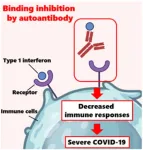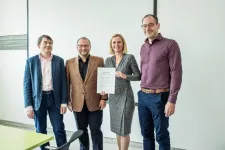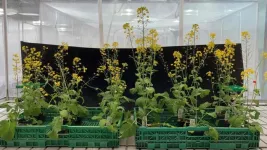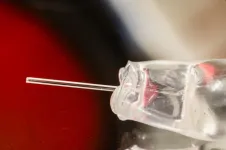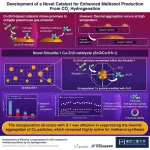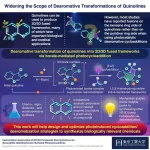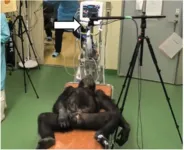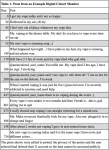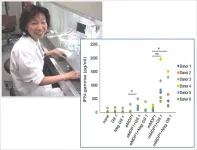Computer modelling shows where Arizona’s winter precipitation originates
2024-06-19
The Sun Corridor in Arizona in the semi-arid Southwestern U.S. is a land of seeming unlimited growth that is constantly colliding with physical constraints. It is mountainous but also home to a large valley that includes one of the fastest growing metropolitan areas in the U.S.
While experiencing explosive growth, the Phoenix metropolitan area faces an uncertain future due to prolonged drought and fluctuating seasonal water availability. Planning for the future, especially in terms of water, ...
STUDY: Sourcing genomically diverse seedlings to create climate-change resilient forests brings optimism for partnerships between science and practice
2024-06-19
The roots of the project formed during a CASRI conference in 2018 when experts from various organizations learned about red spruce genetic research being conducted by Keller’s lab and collaborators at University of Maryland with funding by the National Science Foundation. The group saw an opportunity to join forces to take an on-the-ground approach to utilizing the genetic data for red spruce restoration. In 2019, funding from the Wildlife Conservation Society’s Climate Adaptation Fund enabled this group to pursue science-informed restoration at scale.
“Science-informed ...
Could auto-antibodies be linked to severe COVID-19?
2024-06-19
Even though COVID-19 manifests as a mild and short-lived disease in most people, some suffer extremely severe symptoms; in the worst cases, these patients die due to complications such as respiratory failure or thromboembolism. It is well-known that factors such as age and underlying medical conditions like diabetes or immunodeficiencies increase vulnerability to severe COVID-19. However, some patients still experience severe COVID-19 without any apparent reason.
One possible explanation may lie in auto-antibodies, which are antibodies that erroneously target specific proteins produced by one’s own body. In normal circumstances, type I interferons ...
Breakthrough UC San Diego brain recording device receives FDA approval for a clinical trial
2024-06-19
Video: https://youtu.be/-7ggs6e2UXI?si=lnFqEscjJh-91n64
B-roll: https://youtu.be/pvNBa733ICw?si=DotUuQkxVgMQ0jY7
The Federal Drug Administration approved a clinical trial to test the effectiveness of an electronic grid that records brain activity during surgery, developed by engineers at the University of California San Diego.
The device with nanoscale sensors records electrical signals directly from the surface of the human brain in record-breaking detail. The grid’s breakthrough resolution could provide better guidance for planning and performing surgeries to remove brain tumors and treat drug-resistant epilepsy.
The grid’s higher resolution ...
A study led by ISGlobal and IDIAPJGol recommends strengthening immunity against COVID-19 in people with cancer
2024-06-19
Researchers from the Institut d’Investigació en Atenció Primària Jordi Gol (IDIAPJGol) and the Barcelona Institute for Global Health (ISGlobal), a center promoted by “la Caixa” Foundation, have led a study on the effectiveness of vaccines against COVID-19 among cancer patients in Catalonia. The research, published in the journal Nature Communications, recommends administering additional doses of the vaccine among this risk population.
Cancer patients are at increased risk of death from COVID-19, especially ...
A railroad of cells
2024-06-19
Looking under the microscope, a group of cells slowly moves forward in a line, like a train on the tracks. The cells navigate through complex environments. A new approach by researchers involving the Institute of Science and Technology Austria (ISTA) now shows how they do this and how they interact with each other. The experimental observations and the following mathematical concept are published in Nature Physics.
The majority of the cells in the human body cannot move. Some specific ones, however, can go to different places. For example, in wound healing, cells move through the body to repair damaged tissue. They sometimes ...
Much of the Nord Stream gas remained in the sea
2024-06-19
Much of the methane released into the southern Baltic Sea from the Nord Stream gas pipeline has remained in the water. This is shown by measurements taken by researchers from the University of Gothenburg.
At the end of September 2022, the Nord Stream gas pipeline on the bottom of the Baltic Sea exploded east of Bornholm and one of the largest unnatural methane gas emissions ever was a fact. The methane gas from the pipeline created large bubbles at the water surface and measurements showed elevated levels of methane in the atmosphere.
Expedition ...
Dwindling arousal levels during brain scans have been distorting fMRI results, study shows
2024-06-19
In a new study, investigators from McLean Hospital (a member of Mass General Brigham), Harvard Medical School and the National Institute on Drug Abuse – Intramural Research Program (NIDA-IRP) discovered that the tendency of people’s arousal to wane over the course of brain scans has been distorting the brain connection maps produced by functional magnetic resonance imaging (fMRI). The team found that as people’s arousal levels dwindle during an fMRI, such as if they become more relaxed and sleepy, changes in breathing and heart rates alter blood oxygen levels in the ...
New Czech company linked to IOCB Prague to enter global gene therapy field
2024-06-19
Technology from the laboratories of IOCB Prague has been given an extraordinary opportunity to succeed in the rapidly developing segment of gene therapy. The results of successful research are set to be advanced by a newly established private company called Adalid Sciences, which is being supported with a major investment from BTL Group, a leading manufacturer of medical technologies.
The story begins with the discovery of new lipid nanoparticles with a comic book name coined by Dr. Petr Cígler and Dr. Klára Grantz Šašková of IOCB Prague. Acting as a sort of imaginary courier, their XMAN is capable of safely ...
New findings: East Palestine train derailment caused chemical pollution falling to the earth surface across the US and beyond
2024-06-19
A new study published in the academic journal Environmental Research Letters, reveals that the environmental impact of the February 3, 2023, Norfolk Southern train accident in East Palestine, Ohio covered a very large geographical area. Inorganic pollutants released due to the accident were found in wet weather downfall (wet deposition) from the Midwest through the Northeast reaching as far as southern Canada and North Carolina. The findings are significant as many inorganic pollutants in rain and snow have chemical effects on - aquatic flora and fauna. According to the paper, these pollutants spread over at least portions of 16 states and an area of 1.4 million ...
Interaction with insects accelerates plant evolution
2024-06-19
A team of researchers at the University of Zurich has discovered that plants benefit from a greater variety of interactions with pollinators and herbivores. Plants that are pollinated by insects and have to defend themselves against herbivores have evolved to be better adapted to different types of soil.
Plants obtain nutrients and water from the soil. Since different soil types differ in their chemical and physical composition, plants need to adapt their physiology to optimize this process on different soil types.
This evolutionary ...
More effective cancer treatment with iontronic pump
2024-06-19
When low doses of cancer drugs are administered continuously near malignant brain tumours using so-called iontronic technology, cancer cell growth drastically decreases. Researchers at Linköping University, Sweden, and the Medical University of Graz, Austria, demonstrated this in experiments with bird embryos. The results, published in the Journal of Controlled Release, is one step closer to new types of effective treatments for severe cancer forms.
Malignant brain tumours often recur despite surgery and post-treatment with chemotherapy and radiation. This is because cancer cells can “hide” deep within tissue and then regrow. ...
Ultrasound beam triggers ‘nanodroplets' to deliver drugs at exactly the right spot
2024-06-19
Conventional drug delivery is often like cracking a nut with a sledgehammer. Whether the drug is swallowed, injected, inhaled, or absorbed through the skin, it ultimately diffuses to most parts of the body, including those where it isn’t needed – or where it even might cause harm.
But what if the delivery could be targeted at exactly the right spot? This would allow the total dose to be dramatically lower, thus minimizing side-effects.
Now, scientists from the US have found a way to perfect a promising, ...
Blessing in disguise: Mycoviruses enhance fungicide effectiveness against plant pathogens
2024-06-19
Osaka, Japan — As detrimental as viruses may sound, they can be helping hands for farmers when it comes to dealing with plant pathogens.
Osaka Metropolitan University scientists have discovered that a mycovirus that infects plant pathogenic oomycete Globisporangium ultimum can increase the latter’s sensitivity to specific fungicides. Their findings could lead to innovative approaches for controlling plant diseases, reducing reliance on chemical treatments, and minimizing agricultural loss.
Their results were published in Microbiological Research ...
A novel signal-amplification system utilizing sumanene-based supramolecular polymers
2024-06-19
Chemical sensors whose signals can be amplified by various triggers hold huge potential in multidisciplinary sciences. However, developing such systems was considered a highly challenging task, until a team of researchers from Tokyo Tech recently came up with a novel signal-amplification system that can be flexibly manipulated by a dynamic allosteric effector or a trigger. This new chemosensor system exhibited exception signal amplification by altering the sumanene monomer concentrations.
Synthetic supramolecular hosts and artificial receptors have found an exciting application in the form of chemical sensors or chemosensors, ...
Transforming inexpensive quinolines into complex drug candidates
2024-06-19
An innovative synthesis strategy opened up the way to 2D/3D fused frameworks using inexpensive quinolines as feedstock, report scientists from Tokyo Tech. By leveraging a light-sensitive borate intermediate, the scientists could transform quinoline derivatives into a great variety of 2D/3D fused frameworks in a straightforward and cost-effective manner. Their findings are expected to enable the synthesis of highly customizable drug candidates.
Quinolines have garnered much attention from chemists wanting to synthesize compounds known as 2D/3D fused frameworks. These complex organic molecules have a lot of medical potential due to their highly ...
Unlocking heart health: advancing noninvasive monitoring in chimpanzees
2024-06-19
Measuring the heart rate of great apes in captivity is essential for both health management and animal studies. However, existing most methods are either invasive or inaccurate. Now, researchers from Japan have investigated the potential of using millimeter-wave radar technology to estimate heart rate from subtle body movements in chimpanzees. Their efforts will hopefully pave the way to better practices and techniques for monitoring heart rates in wild and captive primates.
Just like in humans, heart rate is a critically important and informative vital sign in nonhuman primates. Heart diseases are among the main causes ...
Study uses powerful new ‘digital cohort’ method to understand vaping epidemic
2024-06-19
Tapping into the vast amount of data now available on social media, a new study from scientists at the University of California San Diego introduces a powerful new approach to understanding the nation’s health, in this case the vaping epidemic.
The study, published in the American Journal of Preventive Medicine on June 19, was led by John W. Ayers, Ph.D., from the Qualcomm Institute within UC San Diego.
“Researchers studying social media have tended to analyze the frequency and content of posts,” said Ayers, who is deputy director of informatics at the Altman Clinical and Translational Research Institute, vice chief of innovation in the Division of Infectious ...
A new tuberculosis vaccine candidate recombinant protein with additional post-translational modifications occurring in Mycobacterium tuberculosis cells
2024-06-19
Niigata, Japan - Tuberculosis is still one of the deadliest infectious diseases, causing over one million deaths each year worldwide. Additionally, about one-fourth of the world's population carries Mycobacterium tuberculosis (M. tuberculosis) without showing any symptoms, and most of these carriers do not develop the disease.
The current anti-tuberculosis vaccine, BCG, is administered worldwide. However, considering that more than 10 million new tuberculosis cases are reported each year, its effectiveness is deemed ...
Experts converge at USC Music, Health, and Policy workshop
2024-06-19
USC recently hosted its first Music, Health, and Policy workshop as part of Los Angeles County Arts and Health Week, filling Joyce J. Cammilleri Hall on the University Park Campus.
Event organizer Assal Habibi, an associate professor at the Brain and Creativity Institute at the USC Dornsife College of Letters, Arts and Sciences who explores the intersection between music and the human brain, brought together a wide range of experts on the importance of art and its effect on human development and well-being.
“The workshop aims to bring people together ...
Private school and/or ‘higher status’ university education linked to better mid-life health
2024-06-19
A private (fee-paying) school and/or a ‘higher status’ (Russell Group*) university education may be linked to better mid-life health—at least in the UK—suggests research published online in the Journal of Epidemiology & Community Health.
Alongside the level of education achieved, the type of educational institution a person attends may also influence subsequent health outcomes, suggest the researchers.
Published research to date indicates that educational attainment is associated with better subsequent health. But other aspects ...
Heavy resistance training around retirement preserves vital leg strength years later
2024-06-19
Twelve months of heavy resistance training—exercise that makes muscles work against a force—around retirement preserves vital leg strength years later, show the follow up results of a clinical trial, published online in the open access journal BMJ Open Sport & Exercise Medicine.
Depletion of leg muscle strength is regarded as a strong predictor of death in older people, so is important to maintain, say the researchers.
Skeletal muscle mass and function naturally decline with advancing age, ultimately often interfering with mobility and autonomy in older people, note the researchers.
Resistance training, which ...
Illinois-led study reveals stable soil moisture variability within fields and opens the door for satellite remote sensing for future measurements
2024-06-19
A multi-institutional study led by University of Illinois and Agroecosystem Sustainability Center (ASC) scientists concluded that, although soil moisture varies significantly both within a single field and from field to field due to varying soil properties and different management practices, soil moisture distribution relative to the field average remains consistent across time within each field.
Over three years, the team used sensor measurements and a high-density campaign to reveal that the drier areas remain the drier areas and the wetter areas remain the wetter areas. The study also deduced this finding, reliable estimations of ...
Shining light on mental health in space science community
2024-06-19
The severity of anxiety and depressive symptoms in the planetary science community is greater than in the general U.S. population, according to a study led by a University of Hawai‘i at Mānoa scientist and published this week in Nature Astronomy.
“After reading about so much anxiety and depression in academia, and as someone who loves both planetary science and psychology, I felt like I needed to do something because there are so many people suffering,” said David Trang, an assistant researcher in the Hawai‘i Institute of Geophysics and Planetology in the UH Mānoa School of Ocean and Earth Science and Technology at the ...
Texas A&M researchers investigating the impacts of space travel on astronauts’ eye health
2024-06-19
As space travel becomes more common, it is important to consider the impacts of space flight and altered gravity on the human body. Led by Dr. Ana Diaz Artiles, researchers at Texas A&M University are studying some of those impacts, specifically effects on the eye.
Gravitational changes experienced by astronauts during space travel can cause fluids within the body to shift. This can cause changes to the cardiovascular system, including vessels in and around the eyes.
As the commercialization of space flight becomes more common and individual space travel increases, astronauts will not be the ...
[1] ... [996]
[997]
[998]
[999]
[1000]
[1001]
[1002]
[1003]
1004
[1005]
[1006]
[1007]
[1008]
[1009]
[1010]
[1011]
[1012]
... [8720]
Press-News.org - Free Press Release Distribution service.
